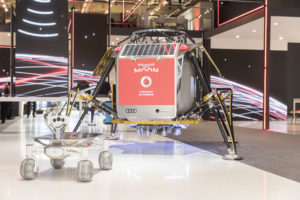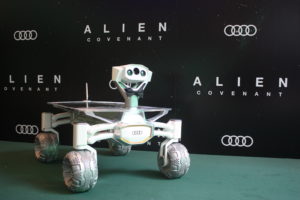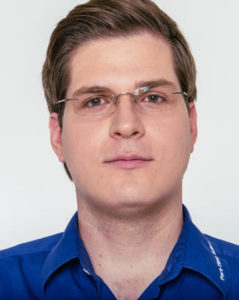
In the sixth and final installment of our #SWMEThemes on Space Resources and the Middle East, Robert Boehme – the CEO and Founder of PTScientists – tells us how his company’s Mission to the Moon is contributing to the commercial exploration of space, and the opportunities on offer to Middle Eastern space programmes to partner with PTScientists.
Tell us how the Mission to the Moon is progressing.
The whole team at PTScientists is working hard on all aspects of the mission. We’ve had a great year so far – our new partnership with Vodafone is really exciting. We’re working with them to put the first LTE base-station on the Moon, and not only will this help to build a future communications infrastructure on the Moon, but it will allow us to stream live video from the rover, via our lander – ALINA – to Earth.
You may have also spotted the Audi Lunar Quattro rover in Alien Covenant, making it perhaps the first piece of space hardware to make a Hollywood debut before being sent to space! It’s been a great way to introduce Mission to the Moon to a whole new audience – people are always surprised and excited when they find out it’s a real Moon rover and not just a prop!
What are the scientific and commercial aims of the Mission to the Moon?
We have always been clear that Mission to the Moon is about more than just proving we can get to the Moon. We have several scientific objectives and technology demonstrations of our own, and we are also carrying scientific payload for a number of partners and customers.
We have chosen the Taurus-Littrow Valley as our landing site – the same place that the final Apollo mission landed. This is no accident! We want use our high definition cameras to get the first close-up look at the original Lunar Roving Vehicle since Gene Cernan and Harrison Schmitt left it on the surface of the Moon 45 years ago during Apollo 17. We hope to gain valuable insights into how well various materials used to build the Moon buggy have stood up to decades in the harsh lunar environment – information that could be useful for those looking to build structures for long-duration lunar missions in future.
Our lunar lander, ALINA, is fitted with two payload racks for delivery of payload to the Moon. One of the experiments we’re taking with us is the Lunar Plant Growth Experiment which will look at how seeds germinate and grow in lunar gravity, only a sixth of gravity on Earth. We are also carrying a highly accurate gravimeter on one of the Audi Lunar Quattro (ALQ) rovers and will take readings of Moon’s gravitational field at different locations.
Commercially speaking, we want to show that there is a business case for lunar exploration, and that it is possible to make a profit with future missions. We’ve had a lot of interest from people looking for a way to get their payload to the Moon or lunar orbit, and we want to bring down the costs of lunar exploration so that many more people can be involved. Up until now, only large national space agencies have had access to the Moon, we want to change that.
Explain why the Moon is so important for getting to Mars, and PTScientists’ ambitions in this regard.
Before we send people to Mars there is still a lot of research that needs to be done and systems that need to be tested. We see the Moon as an ideal testbed for closed-loop life support systems and autonomous vehicles for example. It makes sense to test these a little closer to home where it is possible to return to Earth in case of emergency.
We are using the Moon to test LTE communications, and look at what it would take to create a communications infrastructure on a different celestial body. Using commercial-off-the-shelf parts means that not only can we reduce mission costs, but that other organisations visiting the Moon could utilise the infrastructure that we build, since it doesn’t rely on custom built technology.
What about space resources? What role do PTScientists want to play with regard to space resources?
We are keen to bring down the cost of access to space for everyone, and we hope that this will spark innovation from industry and academia. If people want to develop equipment for in-situ resource utilisation – which will be needed for future deep space exploration – we are happy to help them deliver and test their equipment on the Moon. We can support them all the way from launch to landing on the Moon, and supply communications and power links. We want to be a one-stop shop for helping with lunar exploration – you design your experiment and let us take care of the logistics.

Tell us about your hopes for Middle East involvement in your venture.
Up until recently, space access was limited to major national space programmes and a few large satellite businesses. The development of CubeSats and greater competition in the launch sector has mean that more people around the world can get involved with space missions – even as part of their university degrees. We hope to do the same for the Moon and space exploration – to bring down the costs of access and encourage a far wider range of people to get involved in lunar exploration. We offer an excellent opportunity for nations that haven’t previously had a history of space exploration to get involved, on a national, academic or private level, without having the costs of developing an entire space infrastructure of their own.
Space exploration is an expensive business, and even national agencies recognise that the future of space exploration relies on partnerships. We are open to partnerships at all levels – from space agencies to local universities, the goal for us is to enable more people to reach for the stars, wherever they’re from.
What can PTScientists offer regional space programmes as they look at space science, exploration, and commercial activities in space?
We offer an opportunity for programmes to partner with us or buy payload space on Mission to the Moon and future missions. We are committed to working with payload customers to help design and integrate payloads. You can visit our website ptscientists.com to check the costs per kilogram of payload. This is a great opportunity to fast-track a country’s space ambitions and provide inspiration to a new generation of engineers and scientists.

Robert Boehme is the Chief Executive Officer and founder of PTScientists, and is based in Berlin, Germany.
Original published at: https://spacewatch.global/2017/07/swmethemes-mission-moon-seeks-middle-east-partners-science-resource-exploration/
 SpaceWatch.Global An independent perspective on space
SpaceWatch.Global An independent perspective on space

